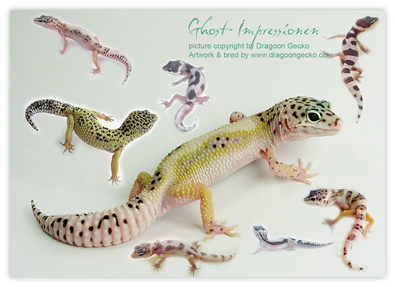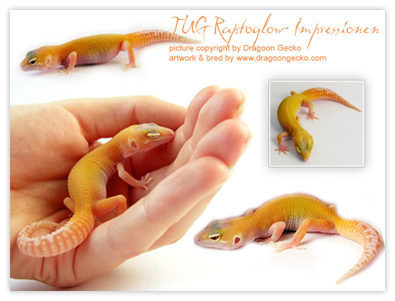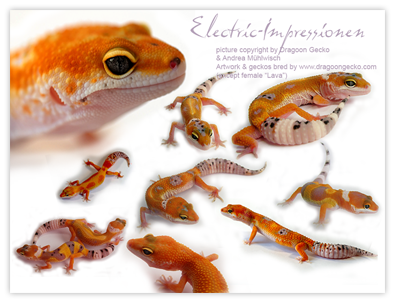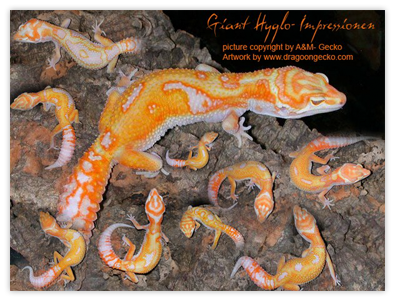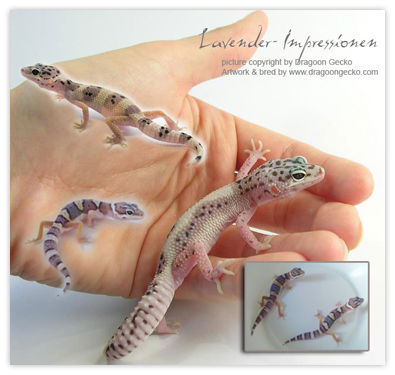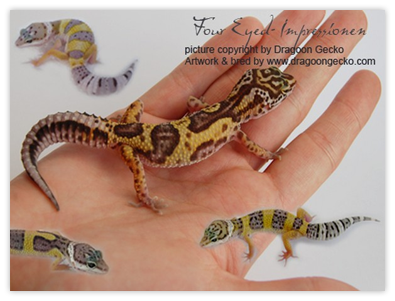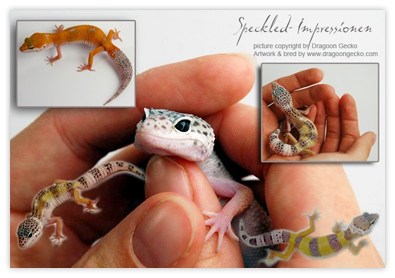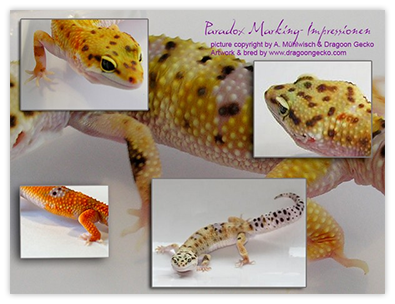Mack Snow Ghost Jungles
Working with the variations of the Ghost gene has been a cornerstone of our work for a long time.
This mutation has been well known as a singular mutation for a long time and as such, almost been forgotten. For years we try to improve Ghosts in appearance and to develop new intriguing combinations such as, e.g., Speckled Ghost.
We are especially known for our Mack Snow Ghost Jungles. These especially attractive animals are a good combination of several separate mutations. Adult animals display bright colours such as sea green, lavender and creamy white with black dots.
The first of their kind appeared in 2007 at “Artlinksgeckos” (Sweden) by accident and caused quite a surge of interest in the international gecko community. We were able to take over the first offspring as well as all breeding animals of this group and have been working exclusively with them ever since. In the following years, our work with them produced among others the first Speckled Ghosts, Speckled Mack Snow Ghost Jungles and Mack Snow Ghost Stripes as well as Ghost Raptors.
For the future we are planning to incorporate Ghosts into many more bloodlines while trying to increase the proportion of lavender and cream and to improve the contrast between black, white, green and violet even more.
TUG- Sunglow Raptor ("Raptoglow" und "Fire-Raptor")
Ever since we started working with Raptors we have been trying to improve the quality of the colouring as well as the general resilience by outcrossing them with other qualitatively high bloodlines.
Following our first experiments with different Tangerine and Giant lines, we quickly realized that we were looking for a Raptor with intense colouring but with little to no markings.
Based on this, the idea of combining the then very fashionable and still impressive TUG Sunglows with Raptors came into being. So, in 2007, we started our first attempts in this new direction, concentrating on Craig’s best Sunglow pair, “Apollo” and “Phoenix”.
In 2010 we finally achieved a breakthrough with our first TUG Raptors! These animals impress with their flawless and strong Sunglow markings and a very nice Carrottail potential.
As you can imagine, we are only at the beginning of a project full of unprecedented possibilities and are therefore very keen of knowing what the future will hold…
The first TUG Fire Raptors and Giant TUG Fire Raptors will be available from 2010 onward!
Electric
These rare and beautiful animals have enriched our breeding stock since 2007.
As one of the first European breeders we were able to gather a lot of important experiences about the exact inheritance of this bloodline during the last few years, which we were able to immediately include into our breeding.
Furthermore, we are among the few who, apart from highly valued Electric crossings, breed pure Electrics from various matings. However, to treat this morph with responsibility and to prevent overproduction, we incubate only a few, highly qualitative, offspring each year:
For instance, in 2010 we only had two pure Electrics and two Electric crosses.
Experience has shown us that the characteristically intensive colouring of Electric offspring is far stronger than among other Tangerine lines and often proportionally connected with the quality of their parents. For this reason you should beware of bargain buys, for many of these cheap animals cannot fulfil the expectations put into them.
Another problem with this morph is that recently, many Electric crosses are being offered which do not have the typical traits and whose provenience is at best questionable.
So, if you want to obtain Electrics with good potential, select both breeder and animals with care and test the breeder’s references and credibility thoroughly.
Giant Hyglo (A & M-Line)
This line came into being relatively early at A & M Geckos in the USA with the initial intention of creating a Super Hypo Tangerine Tremper Albino. Back then, a Hyglo was defined by Alberto Cadolini as “a Super Tangerine Albino with more than 90% of the body being covered by the colour tangerine (= orange).”
Over the years, this project developed into a very characteristic Giant Albino line of its own where the animals display a sharp contrast of creamy white Jungle spots to yellowish-orange base colour with reddish highlights.
During the last years, however, interest in this morph decreased after A&M Geckos closed down their breeding facilities and new mutations appeared. Therefore, it is only rarely offered these days.
We believe that Hyglos are still among the most beautiful and interesting Giant lines and that they still show a lot of potential for the future.
Using our original A&M (Giant) Hyglos as well as unrelated animals of similar phenotype, we intend to try to do our share in conserving this unique bloodline for the future.
Lavender
The light violet colour known as Lavender has been known for a long time among gecko breeders. However, because of its polygenetic inheritance it is difficult to breed since success will only come after years of hard work and intensive selection.
Another problem is that many young animals lose their lavender colouring as they age and mature. As a consequence there are only a handful of good keepers among Lavender lines.
Dragoon Gecko works with different Lavender lines, one of which stems from our own stock and developed from our Four Eyed line, but is not genetically related to any other Lavender lines in existence. Therefore it has proven ideal for crossing them into other Lavender projects.
Careful breeding management with many crossings between different lines enabled us to achieve quick progress within only a few years. Now we will work even harder at improving the clarity of the characteristic violet colour as well as possible.
Four Eyed
During the first years, it was one of our first projects to firmly secure the characteristic “Four Eyed” markings on the heads of our animals. After this was achieved with success five generations later, we began to cross in other bloodlines to improve the colour. Surprisingly, it turned out that the gene pool of this group can be divided into three different types:
- Classical “Four Eyed” as we knew it already
- Animals with unusually high potential for Lavender (Lavender Four Eyed)
- Animals with extremely dark colouring (Dark Four Eyed)
Thus, Four Eyed geckos possess a lot of different colour dispositions und is therefore ideal for Melanistic projects and also yields very good results when crossed in to Lavender liens.
As we had a very sharp eye on vitality and fertility in this bloodline, our Four Eyeds are well known as very strong, reliable and fertile breeding animals. We will continue to work on improving and cultivating this line in order to create more intriguing Four Eyed variations.
Update: One of our Melanistic females, “Smokie”, was moved into the internationally known “Black Velvet” breeding program run by Swedish “Artlinksgeckos”. At this point we would like to extend a heartfelt thanks to Liselott Aaronsson for her trust into our breeding!
Speckled
A short historical review: In 2005, we acquired a breeding female showing a strong tendency towards Speckled from the beginning and passing this trait on to her offspring.
During the years that followed, we continued to work with these animals and were successful in including the Speckled gene into various different colours and markings. Thus, the first Hypo Speckleds, Tangerine Speckleds, Emerine Speckleds, Ghost Speckleds and Speckled Mack Snow Ghost Jungles came into being!
Since 2010, the newest member of our Speckled family is a Speckled Electric, an unexpected and intriguing combination of both our Electric and Speckled lines.
The high-quality variance displayed by our offspring and the strength of inheritance without any inbreeding clearly show the hidden potential of this project which we will continue to work on!
Paradox Markings
Paradox Markings are defined as irregular and sharply marked-off dots on the body of a leopard gecko which can be black and, in rare cases, red.
They belong to the newer mutations and have roused much interest among the breeder community already.
Animals with red or black Paradox markings have appeared in the Dragoon Gecko breeding stock since 2006. One of our Paradox males was included into the book “Il Geco Leopardino” in 2009. With increasing age, this animals keeps on developing more and more Paradox markings, a case which we believe to be unique in Europe.
Additionally, our females intrigue with intensively red Paradox Markings on their bellies, napes and forelegs.
Of the exact genetics of these markings little is known so far – another reason for us to continue working with them during the next years!




